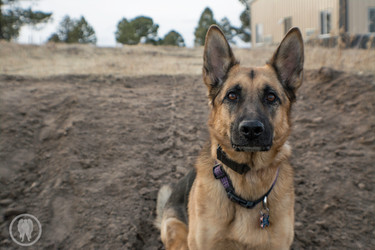Saving a Dog's Life
Posted by Michael Doc Rohan on Jun 14th 2017
I love my dog: in fact, I pretty much love every dog I come across. As a medic, it took me many years to realize I had no idea how to save my favorite animal in all the land and that wasn't going to cut it! Amazingly, dogs and people are quite similar when it comes to first aid. The HABCDE (Hemorrhage, Airway, Breathing, Circulation, Da Brain, Expose and Environment) assessment applies just the same. Today, we’ll discuss approaching a hurt dog and managing massive hemorrhage. Look for future articles covering the rest!
Even the friendliest, most docile dog in town needs to be approached with extreme caution. Your pup is hurt and does not understand why. They can potentially lash out, biting and clawing and severely inhibiting your ability to help your fur baby. If you have a leash or long fabric, make an impromptu muzzle as shown in the image below. This will assist you in moving in closer without being bitten. Don’t leave the muzzle on longer than you need to, however. Your dog can overheat, as they dissipate heat (sweat) by panting. If you’re working with a K9 unit, have the handler perform this process and stick around to help calm the dog. The same goes for a dog owned by someone else.

In terms of managing massive hemorrhage, taking care of your pup is the same as with a human- with some small but important changes. Dog’s legs are very good at stemming massive bleeding, which explains why you may have seen a few stray dogs with 3 legs running around town. However, I’m not going to let that fact determine my own pup’s or a K-9’s treatment. It’s important to note that dog legs are funnel-shaped and make it very difficult to place a standard CAT tourniquet or SOFTT-W. The TQ slides down too easily while attempting to place and/or once the windlass is tightened. For this reason I carry a SWAT-T (Stretch, Wrap and Tuck Tourniquet). Placing concentric wraps high and tight allows the tourniquet to effectively cut off blood flow to the limb. The rubber material also sticks well to itself, so you don’t have worry about it slipping on all that hair.
Along with tourniquets, hemostatic agents like QuikClot and Celox will also work on your pooch. Wound packing and wound care should be used the same way as with humans, avoiding the chest cavity, abdomen and the brain box. Otherwise the application, time held in place and other procedures are identical.
In a future article we’ll discuss treating airway, breathing and all the other good stuff to keep your dog around for many human years to come. Give your dog a treat- I hear he’s been a good boy today!
Save 10% on the K9 D.A.R.K. Trauma Kit using coupon code: MANSBFF

